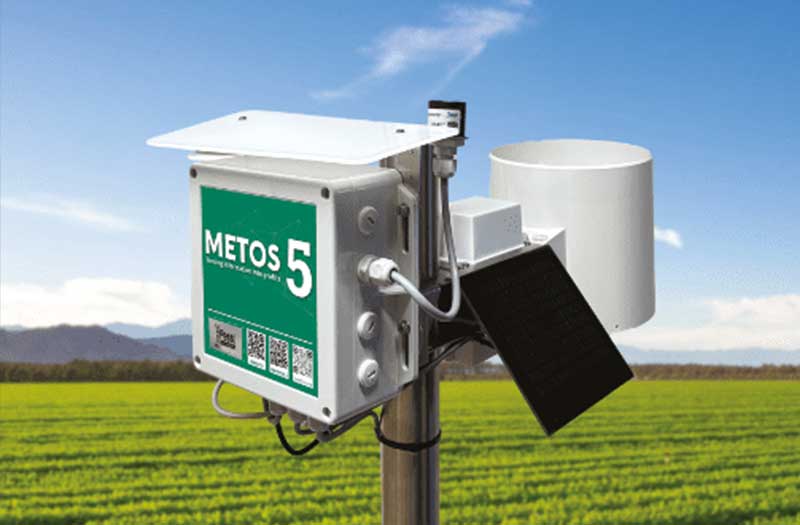Weather-related events play a major role in the success of farm activities, and weed management is no exception. Weeds remain a huge problem in crop production, posing a serious risk of yield loss if left unattended. The effectiveness of herbicide applications for weed management depends on various factors, including environmental conditions before, during and after spraying. For herbicides to work as intended, they must be retained on the plant, absorbed, and translocated to their site of action – processes that can be directly or indirectly influenced by climatic conditions.
Understanding how these factors affect herbicidal activity is important for effective weed control. In this article, we focus on temperature, rainfall and humidity – key factors affecting herbicide performance – because, among the many consequences of climate change, shifts in temperature and rainfall patterns have the most significant impact on agriculture (Park et al., 2021).
Temperature: A double-edged sword
Temperature is a key factor in herbicide efficacy, affecting both the physical properties of the herbicide and the biological responses of weeds. Careful consideration of temperature is therefore essential in any weed management strategy. Temperature can be a double-edged sword when it comes to herbicide performance. High temperatures can accelerate the absorption and translocation of herbicides within weeds, as seen with glyphosate. However, this can also lead to rapid metabolism of the herbicide, reducing its efficacy. For example, Godar et al. (2015) reported that the efficacy of mesotrione on Palmer amaranth (Amaranthus palmeri) was significantly reduced at high day/night temperatures of 40/30°C. Although mesotrione absorption was higher at these temperatures, the herbicide was metabolised rapidly, and less was translocated to the plant’s meristematic tissues, where it is most effective. As a result, Palmer amaranth showed reduced sensitivity to mesotrione under these conditions.
On the other hand, cooler temperatures can slow down these processes, potentially leading to insufficient herbicide uptake and less effective weed control. In contrast to high temperatures, Saini et al. (2016) found that low temperatures, such as frost, reduced the absorption and translocation of clethodim within resistant ryegrass plants, thereby diminishing its efficacy. This effect was more pronounced when these plants were exposed to frost three nights before herbicide application.
In practice, this means that herbicide applications must be timed carefully to avoid extremes in temperature. Monitoring temperature is not just about checking the air temperature, but also about understanding the conditions at the leaf surface where the herbicide is applied. It is essential to apply herbicides when temperature conditions are optimal for absorption. Extreme temperatures, whether hot or cold, can significantly alter the outcome of an application.
Rainfall: The balancing act of soil moisture
Rainfall is another critical factor in herbicide performance, particularly for soil-applied products. Adequate soil moisture is essential for these herbicides to activate and move within the soil profile to target weed seeds. The right balance is key, however. Too much rainfall can lead to leaching, where the herbicide is washed away from the target zone, reducing its effectiveness. Conversely, insufficient rainfall can prevent the herbicide from activating, leaving weed seeds unaffected.
The timing of herbicide application relative to rainfall and soil moisture is crucial. In regions experiencing more erratic rainfall patterns due to climate change, the use of tools like on-farm weather stations becomes invaluable. These stations allow for real-time monitoring of soil moisture conditions and rainfall forecasts, enabling more precise application timing.
Humidity: The silent influencer
Humidity, often overlooked, plays a significant role in the performance of foliar-applied herbicides. High humidity levels can enhance herbicide absorption by prolonging the moisture on leaf surfaces, which allows more of the active ingredient to penetrate the plant. Also, under high humidity, plants keep stomata open longer, facilitating greater absorption and translocation within the plant. Conversely, under low humidity conditions, rapid evaporation can reduce herbicide uptake and increase the risk of volatility to non-target plants.
Ouse et al. (2018) found that the volatility of the auxin-type herbicide 2,4-D dimethylamine was notably higher at 20% relative humidity compared to 50%. This illustrates how even modest changes in atmospheric conditions can significantly influence herbicide performance.
Delta T: Indicative of evaporation rate and droplet lifetime
Delta T, measured in °C, is indicative of evaporation rate and droplet lifetime, i.e. the survivability of the droplet. Delta T is the relationship between the dry and the wet-bulb temperature, or the air temperature and relative humidity. A common spray guideline is to spray when Delta T is between 2 and 8°C.
- Ideal: 2 – 8°C
- Low: < 2°C
- High: > 10°C
Precision agriculture – optimising herbicide application with on-farm weather stations
In the face of increasingly unpredictable climate conditions, precision agriculture tools such as METOS® weather stations offer farmers a powerful way to optimise herbicide applications. These stations provide real-time, hyper-localised weather data. They also offer additional planning tools, such as optimal spray windows, which can help farmers schedule their activities based on 3-, 7- and 14-day weather forecast data.
By using this technology, farmers can make informed decisions about the timing and conditions of herbicide use, which is crucial for effective weed management. METOS® weather stations continuously monitor key environmental variables such as temperature, humidity, wind speed and soil moisture.
Delta T
One of the key features of METOS® weather stations is the ability to monitor Delta T, which is the difference between dry-bulb and wet-bulb temperatures. This metric is vital for assessing evaporation rates and ensuring the herbicide remains effective. A high Delta T can indicate the risk of spray drift, while a low Delta T suggests conditions may lead to run-off. Farmers can time their applications when Delta T is in the optimal range, i.e. between 2 and 8, improving herbicide retention on leaves and enhancing weed control.
Historical data and long-term planning
As the well-known Jim Barksdale quote puts it, “If we have data, let’s look at data. If all we have are opinions, let’s go with mine.” Fortunately, METOS® weather stations not only provide real-time data but also store historical weather data. This enables farmers to analyse patterns and adjust their long-term weed management strategies. Understanding how past weather events affected herbicide performance can improve future application timing and decision-making. With this technology, farmers can take a more data-driven approach to their weed management strategies.
Final insights
In the face of a changing climate, optimising herbicide efficacy requires a deep understanding of how environmental factors such as temperature, rainfall and humidity interact. By leveraging tools like METOS® weather stations and integrating them into weed management practices, we can enhance the precision and effectiveness of herbicide applications. Ultimately, this data-driven approach leads to more sustainable and successful weed management over the long term. The result? Healthier crops, happier farmers.
References
Godar, A.S., Varanasi, V.K., Nakka, S., Prasad, P.V., Thompson, C.R. and Mithila, J., 2015. Physiological and molecular mechanisms of differential sensitivity of Palmer amaranth (Amaranthus palmeri) to mesotrione at varying growth temperatures. PLOS One 10(5), p.e0126731.
Ouse, D.G., Gifford, J.M., Schleier, J., Simpson, D.D., Tank, H.H., Jennings, C.J., Annangudi, S.P., Valverde Garcia, P. and Masters, R.A., 2018. A new approach to quantify herbicide volatility. Weed Technology, 32(6), pp.691-697.
Park, H.H., Lee, D.J. and Kuk, Y.I., 2021. Effects of various environmental conditions on the growth of amaranthus patulus bertol. And changes of herbicide efficacy caused by increasing temperatures. Agronomy, 11(9), p.1773.
Saini, R.K., Malone, J., Preston, C. and Gill, G.S., 2016.Frost reduces clethodim efficacy in clethodim-resistant
rigid ryegrass (Lolium rigidum) populations. Weed Science, 64(2), pp.207-215.

